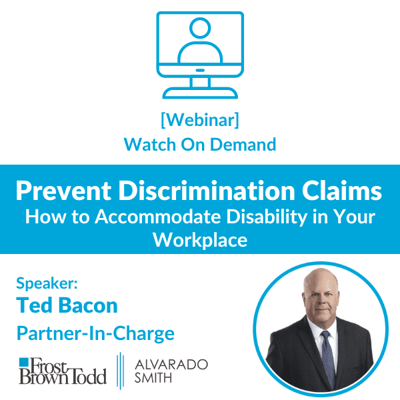5 Best Practices for ADA Compliance in the Workplace
June 9th, 2023 | 6 min. read

Over one-third of all workplace discrimination claims in the U.S. in 2020 were the result of disability discrimination, with nearly 25,000 lawsuits filed. Even more alarming, this growing statistic makes disability the nation’s most commonly reported type of discrimination.
If you’re now wondering whether your current approach to disability accommodation in the workplace is compliant, this rising number of disability discrimination claims is your sign to take a close look at it and make sure it is in line with the requirements of The Americans with Disabilities Act (ADA).
Here at Combined, our HR team has assisted countless employees with their workplace policies and procedures. We have the resources to keep you informed on proper workplace disability protocol and the experience to help you update your policies so that you won’t have to worry about facing a disability discrimination lawsuit.
In this article, we will discuss what is considered a disability and how to reasonably accommodate disability under the ADA. By reading it, you will learn the 5 best ways to adhere to ADA requirements in your workplace and prevent disability discrimination claims.
What is the Americans with Disabilities Act (ADA)?
Before diving into ADA compliance, here is an overview of the civil rights law protecting against disability discrimination.
Passed in 1990, the U.S. Department of Labor explains that the ADA “prohibits discrimination against people with disabilities in several areas, including employment, transportation, public accommodations, communications, and access to state and local government programs and services.”
As it relates to equal opportunity employment, the ADA stipulates that employers have an obligation to provide reasonable accommodations to qualified employees and job seekers alike.
And, to safeguard disability protections and simplify compliance with the criteria of the ADA, the key legal terms are clearly defined within.
What is a disability?
The ADA qualifies disability as a physical or mental impairment that substantially limits a person in one or more of their day-to-day life activities.
Using this definition, the ADA extends protection to those with a current disability, those with a record of a past disability, as well as those who are regarded as having a disability.
As an employer, you are required to provide reasonable accommodation in the workplace for those who meet any one of the above provisions.
What is a reasonable accommodation?
A reasonable accommodation in the workplace refers to modifications or adjustments made to customary job processes or the job environment to allow individuals with disabilities an equal opportunity of employment.
Titled “reasonable accommodations,” these workplace changes must be reasonable for an employer to be able to successfully implement.
While the nature of what is considered reasonable may change depending on the size and resources of an organization, the nature of the disability, and the specific context of accommodation, the following factors generally guide this determination:
- Is the accommodation both logically plausible and realistically feasible?
- Will the accommodation be effective at meeting the individual’s specific needs?
- Can the accommodation enable the individual to perform all essential job functions?
If an employer’s accommodation strategy affirms these 3 questions, it is likely a reasonable accommodation.
A few examples of reasonable accommodations include:
- Installing ramps or elevators for wheelchair accessibility
- Supplying technology to assist with limitations
- Providing additional training or support
What is not a reasonable accommodation?
A reasonable accommodation, as a legal term and an ADA provision in the workplace, is intended to promote inclusivity and ensure that individuals with disabilities have equal employment opportunities. However, it is not intended to pose an undue hardship to employers.
With this in mind, an accommodation is not reasonable if:
- The accommodation places an employer under financial difficulty
- The accommodation is excessively extensive, substantial, or disruptive
- The accommodation alters the fundamental make-up or operation of a business
If an employer’s accommodation strategy is termed to meet any of these 3 conditions, it is likely an unreasonable accommodation.
A few examples of accommodations that are not reasonable include:
- Eliminating a core job function
- Creating or customizing a new position
- Reassigning an individual to a role they are not qualified for
What is the Americans with Disabilities Act (ADA)?
Before diving into ADA compliance, here is an overview of the civil rights law protecting against disability discrimination.
Passed in 1990, the U.S. Department of Labor explains that the ADA “prohibits discrimination against people with disabilities in several areas, including employment, transportation, public accommodations, communications, and access to state and local government programs and services.”
As it relates to equal opportunity employment, the ADA stipulates that employers have an obligation to provide reasonable accommodations to qualified employees and job seekers alike.
And, to safeguard disability protections and simplify compliance with the criteria of the ADA, the key legal terms are clearly defined within.
1. The Request
When an employee requests an accommodation for a disability in accordance with company policy, you need to be receptive and actionable. Appropriately placed requests should be immediately brought to HR for the next steps.
2. The Response
Following an accommodation request, the employee should be provided an overview of ADA accommodation information and given a disability questionnaire to explain the reason for their request and the nature of their disability, as well as offer other relevant details.
3. The Solution
Next, you review all documentation and have an interactive conversation with the employee in order to constructively work toward a reasonable accommodation. As part of this step, you may research accommodation options that match your employee’s essential job functions, compare accommodations provided to others, and even speak with your employee’s supervisor to determine the best-fit solution.
4. The Offer
Once you find an ADA-compliant accommodation strategy, you just have to implement it by issuing the employee a formal offer in writing, outlining the terms of the accommodation. Whether options like an altered work schedule, a leave of absence, or specialized work equipment were previously discussed, you still need to make the offer in writing and have it accepted before you apply it.
5. The Review
And finally, it’s important that you monitor an accommodation after implementing it to confirm whether it is having the desired outcome. By following up with your employee and their supervisor, you can make necessary adjustments to ensure your employee is able to function optimally in their role.
Note: Confidentiality should be exercised throughout The Interactive Process
All medical information should be kept private in a separate file, no details of disability or the specific accommodation should be shared with coworkers, and even information given to supervisors should be limited to particulars of the accommodation itself and not the disability.
5 Best Practices for ADA Compliance in the Workplace
While adhering to The Interactive Process is simple enough, here at Combined we want to make it even easier for you.
These 5 best practices for ADA compliance can help you better manage disability accommodation in your workplace and safeguard you from experiencing discrimination claims now and moving forward.
1. Collaboration is key
When it comes to identifying an effective accommodation, it’s crucial for you and your employee to work together to find an adequate solution. After all, an accommodation is only successful when both the needs of the employee and the requirements of the job are met.
2. Trust is a must
In order to collaborate, there has to be transparent communication – And transparent communication requires trust. Your employees need to be comfortable disclosing sensitive personal information to you when requesting an accommodation, which is in and of itself, a measure of trust.
Without developing a trusting relationship with your employees, a situation involving disability that an accommodation could improve may go unnoticed or be attributed to other performance factors.
3. There’s a common goal
You want your employee to suitably perform the essential functions of their job. And your employee also wants to suitably perform the essential functions of their job. When a disability without an accommodation factors into performing essential job functions, neither you nor your employee get what you want.
A successful accommodation can create a scenario where you both do. In the case of disability, an accommodation empowers your employee to perform better and, as a result, you see elevated productivity. It’s a win-win!
4. But each case is different
Disability is different for everyone. The accommodation that works well for one employee may not be the right solution for another.
In other words, disability accommodation needs to be considered and created, as well as given attention and ongoing communication, on an individual basis.
Having clear, standardized workplace accommodation policies and procedures allows your employees the opportunity to request a solution for disability. Taking the time to personalize each solution on a case-by-case basis, however, ensures that the accommodation you choose to offer is effective.
5. Be resourceful
When developing an accommodation plan use credible resources like the Job Accommodation Network to help you find the best possible solution. And explore all of your options – In today’s technology-driven age, you have access to ever-improving tools, devices, and software that may be the right accommodation for a disability request.
Take the next steps to complete ADA compliance in your workplace
Navigating disability in the workplace can be complicated. You are here, because you want to make sure, despite the complexity, that your approach to accommodating disability is effective for you and your employees while also meeting ADA requirements.
By reading this article, you learned not only how to comply with the ADA and prevent disability discrimination claims, but the 5 best ways to adapt ADA regulations to your workplace.
Here at Combined, our HR team has assisted countless employees with their workplace policies and procedures. We can help you develop ADA-compliant disability policies personalized to your employees and your business.
This article is not intended to be exhaustive nor should any discussion or opinions be construed as legal advice. Readers should contact legal counsel for legal advice.
Topics:
.png?width=1125&height=426&name=Your%20paragraph%20text%20(5).png)

